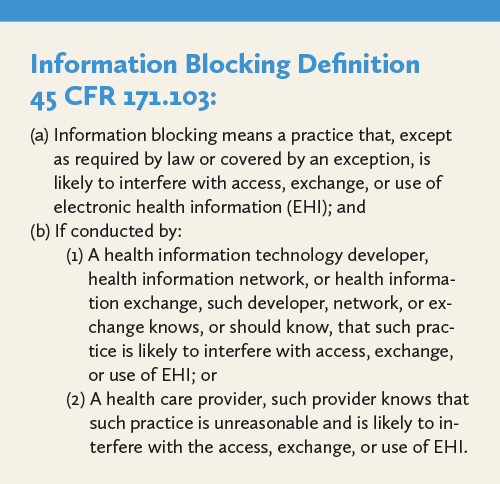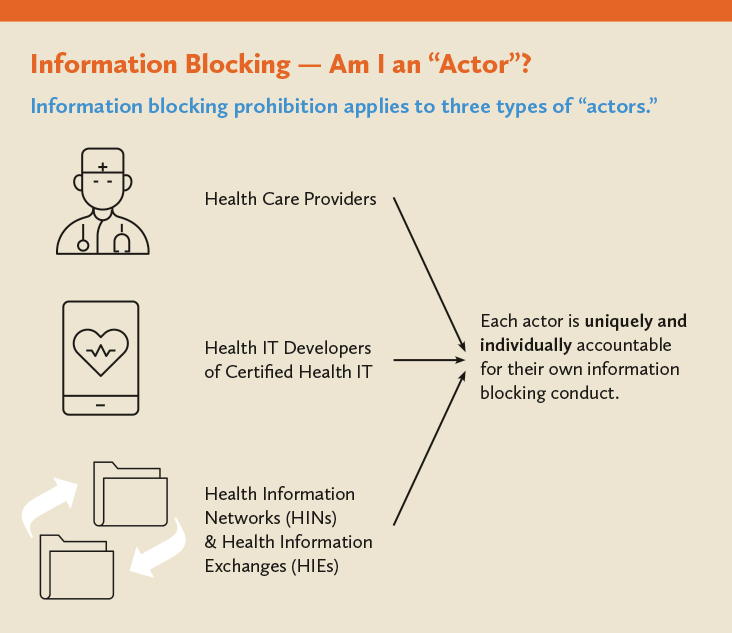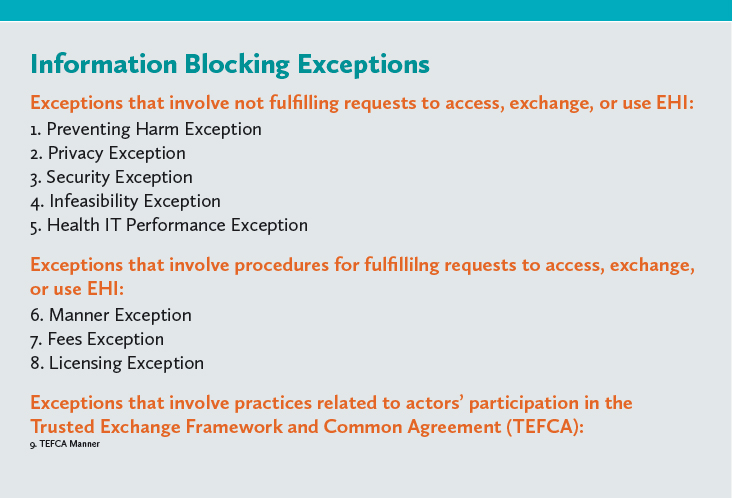Navigating the Federal Information Blocking Regulations
What you need to know about information sharing, the information blocking regulations, and why they are important to you.
Daniel Ciolek
6/1/2024
The year 2024 is all about information sharing, and long term and post-acute (LTPAC) providers have the federal rules that support this. Are you receiving an increase in requests for health care information in an electronic format from providers, residents, payers, and others? Sharing electronic health information (EHI) when and where it is needed requires thoughtful implementation of health information technology (HIT)-supported workflows and processes.
 Recently implemented information blocking regulations support the secure, appropriate sharing of EHI as providers expand their HIT capabilities. Electronic information sharing can also improve operational efficiencies, care outcomes, and patient engagement.
Recently implemented information blocking regulations support the secure, appropriate sharing of EHI as providers expand their HIT capabilities. Electronic information sharing can also improve operational efficiencies, care outcomes, and patient engagement.
On February 22, 2024, the Department of Health and Human Services (HHS) Office of the National Coordinator for Health Information Technology (ONC)1 provided a 60-minute webinar2 directed to the unique needs of LTPAC providers to help provider staff and compliance officers involved in the exchange of health information with external entities, including other providers, residents, and their families or representatives. The webinar was hosted by the LTPAC HIT Collaborative³ that the American Health Care Association and National Center for Assisted Living (AHCA/NCAL) are a member of, and AHCA/NCAL assisted in the webinar content development.
In this information-packed webinar, the ONC speakers, Dan Healy, MPP and Rachel Nelson, JD, provided specific insights and resources to attendees, including sharing an overview of specific regulations, addressing common questions and issues by identifying relevant parts of the regulations, and highlighting additional resources created by ONC. Participants attending this webinar reported they gained a better understanding of the information blocking regulations, how the regulations affect the sharing of EHI, and why the successful implementation of the requirements is important to LTPAC providers.
 Specific topics related to information blocking regulations discussed in the webinar include the following:
Specific topics related to information blocking regulations discussed in the webinar include the following:
- What are the statutory and regulatory definitions of what is prohibited?
- How to identify who are considered information blocking “actors.”
- What EHI is subject to the requirements?
- What is considered a potential interference?
- What are the regulatory enforcement roles and timelines?
- What are the answers to common questions from LTPAC providers?
- Where do providers find more information?
Examples of some of the specific questions answered in detail and with real-world examples by the ONC presenters included:
- I am a skilled nursing facility/home health entity/long term care facility/nursing facility. Am I considered a health care provider subject to the information blocking regulations?
- Is a health care provider who does not participate in Medicare or Medicaid still an “actor” under the information blocking regulations?
- Are health care providers who do not use any certified health information technology (IT) subject to the information blocking regulations?
- What is EHI?
- How do I know if my information is EHI?
- Why is EHI important?
- Are nursing, pharmacy, or other professions’ clinical notes included in the definition of EHI?
- How does the EHI definition align with Health Insurance Portability and Accountability Act (HIPAA) privacy regulation’s health care terminology?

- Is EHI covered by the information blocking regulations limited by when the information was generated?
- Is an actor required to fulfill a request for access, exchange, or use of EHI with all the EHI they have for a patient or should the amount of EHI be based on the details of the request? In addition, what if an actor only maintains some of the requested information electronically?
- Do the information blocking regulations require actors to have or use certified health IT, or upgrade the certified health IT they already have, in order to fulfill a request to access, exchange, or use EHI?
- When would a delay in fulfilling a request for access, exchange, or use of EHI be considered an interference under the information blocking regulation?
- Are there exceptions to the information blocking requirements?
- What are the consequences for information blocking?
Slides of the presentation containing multiple links to important resources can be downloaded at https://www.ltpachit.org/post/onc-information-blocking-in-ltpac-webinar-now-available-on-demand.
 Providers are highly encouraged to view this webinar. Although the ONC information blocking webpage contains extensive resources, including plain-language fact sheets, frequently asked questions, brief explanatory YouTube videos, and links to detailed information and source policies, the sheer volume of information can be somewhat intimidating for providers and patients. The LTPAC HIT Collaborative appreciates that the ONC agreed to develop this webinar to provide a foundational roadmap for providers to understand the basics of the information blocking regulations applied to their setting and to provide information on where to go to learn more about how to share electronic health care information appropriately.
Providers are highly encouraged to view this webinar. Although the ONC information blocking webpage contains extensive resources, including plain-language fact sheets, frequently asked questions, brief explanatory YouTube videos, and links to detailed information and source policies, the sheer volume of information can be somewhat intimidating for providers and patients. The LTPAC HIT Collaborative appreciates that the ONC agreed to develop this webinar to provide a foundational roadmap for providers to understand the basics of the information blocking regulations applied to their setting and to provide information on where to go to learn more about how to share electronic health care information appropriately.
Daniel Ciolek is associate vice president, therapy advocacy, for the American Health Care Association.